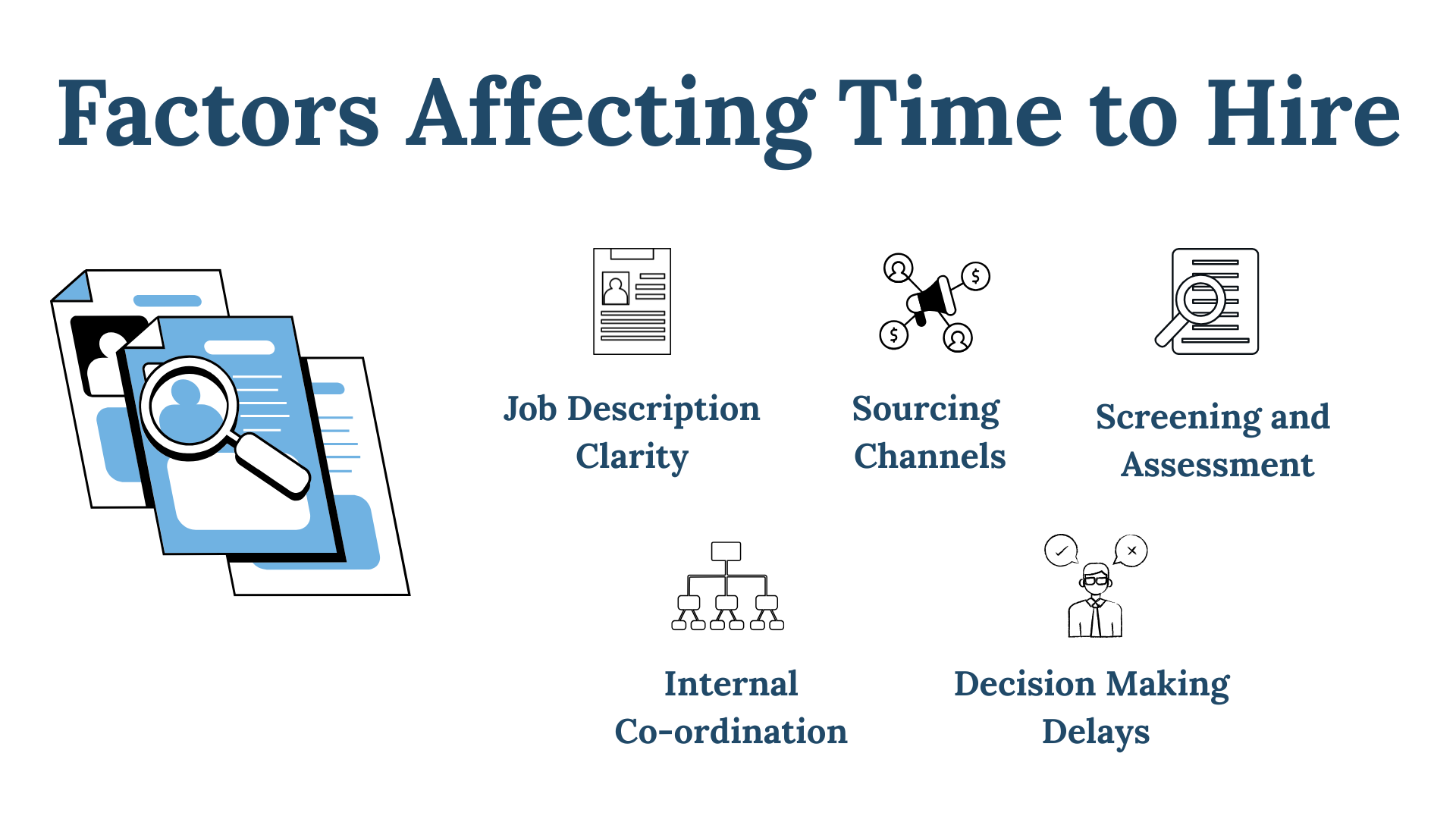Hiring great talent can feel like a race against time. Every day a position remains open, teams slow down, projects stall, and opportunities slip through the cracks. One of the most telling indicators of how efficient your hiring process is lies in a single metric: Time to Hire.
Understanding and improving this metric can transform how your organization recruits. In this guide, we’ll break down what is Time to Hire, why it matters more than many realize, and how to optimize it without compromising the quality of your hires.
What Is Time to Hire?
Time to Hire measures how long it takes for a candidate to move through your hiring process, from the moment they enter your recruitment pipeline to the day they accept your offer. It focuses specifically on the efficiency of the selection and decision-making stages.
This metric is often confused with Time to Fill, but they represent different parts of the process.
-
Time to Hire starts when a candidate applies or is sourced.
-
Time to Fill begins when the job is officially opened and ends when the position is filled.
In other words, Time to Hire measures the candidate’s journey, while Time to Fill measures the company’s hiring timeline.
A clear grasp of this distinction helps recruiters pinpoint where delays are actually happening, whether it’s in sourcing or in screening and decision-making.
Example:
If you source a candidate on March 1 and they accept the offer on March 20, your Time to Hire is 19 days.
Tracking this consistently allows you to see patterns, spot inefficiencies, and make targeted improvements.
Why Time to Hire Matters
Recruiting efficiency isn’t only about speed; it’s about maintaining momentum and ensuring the process aligns with both candidate expectations and business needs. A long, drawn-out hiring cycle can cost more than just time.
Here’s why this metric deserves serious attention:
1. Candidate Experience
Candidates notice how long it takes to hear back after applying or interviewing. Delays often signal disorganization or a lack of interest. A smooth and timely process keeps candidates engaged and creates a positive impression of your brand. In competitive markets, this difference can determine whether a top candidate joins your company or accepts another offer.
2. Cost and Productivity
Every unfilled role has a financial impact. Projects slow down, existing employees absorb extra work, and business outcomes suffer. A shorter Time to Hire reduces these costs and keeps your team performing at full capacity.
3. Competitive Advantage
Top talent doesn’t stay available for long. Companies with a faster Time to Hire can secure strong candidates before others even finish their second interview round. Being quick to decide isn’t about rushing, it’s about being prepared to act when the right person appears.
4. Process Efficiency
Tracking Time to Hire reveals where your recruitment pipeline gets stuck. Maybe interview scheduling takes too long or feedback loops are unclear. When you measure this consistently, you can identify bottlenecks and streamline specific steps instead of guessing where delays occur.
What are the Factors Affecting Time to Hire?
When it comes to optimizing the hiring process and reducing the time-to-hire, several factors come into play. Understanding these factors can help you streamline your recruitment efforts and find the best candidate for your organization in a shorter time frame. Let’s explore the key elements that influence the time it takes to fill a job opening.
1. Clarity of Job Descriptions
A vague or overly broad job description attracts the wrong applicants, leading to longer screening times. Clear and specific descriptions help filter out unqualified candidates early and speed up the entire process.
2. Sourcing Channels
Where you look for candidates matters. Relying too heavily on a single platform can slow you down if response rates are low. Using a balanced mix of sourcing methods such as job boards, employee referrals, social recruiting, and talent networks improves both reach and efficiency.
3. Screening and Assessment
Manual resume reviews and inconsistent evaluation criteria can extend the hiring process unnecessarily. Automated screening tools, standardized interview scorecards, and structured assessments bring consistency and allow faster, fairer comparisons.
4. Internal Coordination
Poor communication between recruiters, hiring managers, and interview panels is one of the most common causes of delay. Without clear ownership and timelines, candidates often end up waiting for feedback. Establishing defined responsibilities, setting decision deadlines, and ensuring accountability help keep the process on track.
5. Decision-Making Delays
Sometimes the hiring process moves quickly until the final stage, and then everything slows down. Uncertainty about compensation, job title, or cultural fit can add days or even weeks. When hiring teams agree in advance on salary ranges, key requirements, and decision criteria, they can make confident choices more quickly.
How to Improve Your Time to Hire
Improving Time to Hire doesn’t mean rushing decisions; it’s about designing a process that moves efficiently from one step to the next. Here are practical ways to achieve that:
1. Optimize Job Postings
Write job descriptions that clearly outline responsibilities, skills, and growth opportunities. Use relevant keywords so that the posting reaches the right audience through search and job boards.
2. Automate Repetitive Tasks
Adopt an Applicant Tracking System (ATS) to organize resumes, schedule interviews, and send updates automatically. This reduces administrative burden and prevents candidate drop-offs caused by delays in communication.
3. Pre-Screen Candidates with AI Tools
AI-powered sourcing and screening platforms can evaluate resumes and online profiles to identify top matches instantly. These tools help recruiters focus on quality interactions rather than manual filtering.
4. Streamline Interview Scheduling
Interview coordination is often a major time sink. Use scheduling software that syncs calendars and allows candidates to choose available slots. This alone can shave days off your hiring timeline.
5. Standardize Interview Feedback
Create consistent scoring rubrics so interviewers evaluate candidates using the same criteria. Clear feedback formats help hiring managers compare candidates quickly and objectively.
6. Maintain Candidate Communication
Regular updates build trust. Even short messages about next steps keep candidates engaged and reduce the likelihood of them accepting another offer while waiting.
7. Track and Review Your Metrics
Time to Hire isn’t a “set and forget” metric. Review it regularly alongside related metrics such as source of hire, offer acceptance rate, and candidate satisfaction score. Data-driven reviews reveal where your process can be refined further.
What Is a Good Time to Hire?
The ideal Time to Hire varies by industry, role complexity, and company size. However, there are general benchmarks that can serve as useful reference points:
| Industry | Average Time to Hire |
|---|---|
| Technology | 30–45 days |
| Healthcare | 25–35 days |
| Marketing | 20–30 days |
| Retail | 10–20 days |
| Finance | 25–40 days |
These are not hard rules. What matters most is how your company’s performance compares to its own historical data. If your average Time to Hire was 45 days last quarter and you’ve brought it down to 30, that’s measurable progress. The goal is steady improvement, not perfection.
Key Takeaways
-
Time to Hire measures how quickly a candidate moves from first contact to offer acceptance.
-
Monitoring this metric helps identify inefficiencies and improve recruitment speed.
-
A shorter Time to Hire improves candidate experience, reduces costs, and strengthens your competitive edge.
-
Technology, clear communication, and data-driven decision-making are key to optimizing this process.
Efficient hiring isn’t just about speed; it’s about creating a process that respects both the candidate’s time and the company’s needs. When done right, reducing your Time to Hire leads to better talent, stronger teams, and a hiring experience that reflects well on your brand.
Conclusion
Time to Hire is more than just a number on a dashboard. It reflects how efficiently your organization can identify, evaluate, and secure the right people. A long hiring cycle often signals communication gaps, unclear processes, or outdated tools, while a well-optimized timeline shows a company that values both speed and candidate experience.
Improving this metric requires balance. Moving too quickly can lead to rushed decisions, but a thoughtful, structured process supported by clear communication and the right technology can shorten hiring time without compromising quality.
When organizations track Time to Hire consistently, they gain visibility into what works and what slows them down. Over time, this awareness leads to better planning, lower costs, and a hiring experience that leaves a positive impression on every candidate. In a competitive job market, that combination can make all the difference.
FAQs about Time to Hire
1. What is the difference between Time to Hire and Time to Fill?
Time to Hire measures the days between when a candidate enters your pipeline and when they accept an offer. Time to Fill tracks the entire period from posting the job to closing it.
2. Why is Time to Hire an important recruitment metric?
It reflects how efficiently your hiring process operates. A shorter Time to Hire improves candidate engagement, reduces costs, and helps secure top talent before competitors do.
3. What tools help reduce Time to Hire?
Applicant Tracking Systems (ATS), AI screening platforms, automated scheduling tools, and candidate relationship management systems all help streamline recruitment stages.
4. Can Time to Hire be too short?
Yes. If hiring happens too quickly without proper evaluation, the risk of poor fit increases. The goal is balance, fast enough to stay competitive but thorough enough to ensure quality.
5. How often should Time to Hire be tracked?
Track it continuously and review it at least quarterly. Comparing results across roles, departments, and time periods helps you spot trends and measure improvement.


